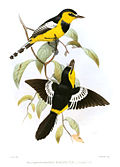Crypsirina
In this article we will explore the exciting world of Crypsirina, from its origins to its relevance today. Crypsirina has been a topic of interest for many people throughout history, and its influence extends to different areas of daily life. Since its inception, Crypsirina has sparked debates and reflections, generating a wide variety of opinions and perspectives. Throughout these pages, we will delve into the most relevant aspects of Crypsirina, analyzing its impacts, implications and possible future developments. Get ready to immerse yourself in a fascinating journey through the world of Crypsirina!
This article includes a list of general references, but it lacks sufficient corresponding inline citations. (January 2013) |
| Crypsirina | |
|---|---|

| |
| Crypsirina cucullata | |
| Scientific classification | |
| Domain: | Eukaryota |
| Kingdom: | Animalia |
| Phylum: | Chordata |
| Class: | Aves |
| Order: | Passeriformes |
| Family: | Corvidae |
| Subfamily: | Crypsirininae |
| Genus: | Crypsirina Vieillot, 1816 |
| Type species | |
| Corvus varians[1] Latham, 1801
| |
| Species | |
| |
Crypsirina is a small genus of long-tailed passerine birds in the crow and jay family, Corvidae. The two species are highly arboreal and rarely come to the ground to feed.[2] The generic name is derived from the Greek words kruptō, meaning "to conceal," and rhis or rhinos, meaning "nostrils".[3]
They are:
| Common name | Scientific name and subspecies | Range | Size and ecology | IUCN status and estimated population |
|---|---|---|---|---|
| Racket-tailed treepie | Crypsirina temia (Daudin, 1800) |
southern Burma (Myanmar), Thailand, Indo-China, Sumatra, Java and Bali | Size: Habitat: Diet: |
LC
|
| Hooded treepie | Crypsirina cucullata Jerdon, 1862 |
Burma | Size: Habitat: Diet: |
NT
|
The racket-tailed treepie, formerly placed in Dendrocitta, is an all-black Southeast Asian species. The grey and black hooded treepie is endemic to Myanmar.
References
- ^ "Corvidae". aviansystematics.org. The Trust for Avian Systematics. Retrieved 2023-07-16.
- ^ Madge, Steve; Burn, Hilary (1994). Crows and Jays: A Guide to the Crows, Jays and Magpies of the World. Christopher Helm. ISBN 0-7136-3999-7.
- ^ Jobling, James (2010). Helm Dictionary of Scientific Bird Names. Christopher Helm. p. 128. ISBN 978-1-4081-2501-4.









